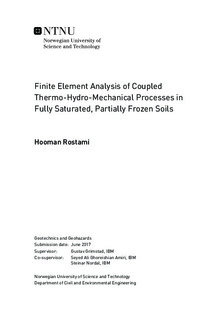| dc.description.abstract | Interest in permafrost, or seasonally frozen ground, has been increasing over the last decades. Nearly 24% of the northern hemisphere, is covered with permafrost. Humankind's need for energy and raw materials has pushed technology to operate on these frozen grounds. Construction and operation of infrastructures, such as roads, pipelines, and tunnels on these areas mean engineers have to deal with frozen soil. In addition, with climate change, permafrost warming and subsequent thawing can trigger or accelerate natural hazards, like rockfalls and debris flows. Furthermore, there is a growing interest in artificial ground freezing for stopping groundwater flow into the construction sites, for example in tunnels, and also for strengthening soil mass to improve stability.
There are fundamental differences between frozen soil and unfrozen soil, such as frost heave, thaw settlement, cryogenic suction which yearn for a new body of knowledge in this area. Saturated frozen soil is a mixture of soil grain, ice and unfrozen water. Thermo-hydro-mechanical interaction between different phases of such a mixture is the cause of strengthening of the frozen soil and its volume expansion during freezing. Also, the behavior of frozen soil depends on temperature and confining pressure.
A new constitutive model called Elastoplastic Frozen Soil Model, which is based on Modified Cam Clay Model, was developed at NTNU to represent the behavior of frozen soils. The model uses two-stress state concept and is able to represent fundamental and crucial behaviors of frozen soil, such as ice segregation phenomenon, thawing consolidation and thaw settlement, and strength weakening due to pressure.
This model has been validated before and here in this thesis, boundary value problems were run to show the validity and capability of the model to correctly represent the real BVPs. A large-scale laboratory experiment, which was run in the 80s and the 90s in Canada, was chosen as the BVPs. In this experiment, a chilled pipe was causing heave in a frost-susceptible soil. This BVPs were successfully modeled and simulated and they showed a good correspondence between numerical simulation and experimental results. The temperature contour plot and heave was compared and good corresponding between numerical simulation and experimental results were obtained. | |

